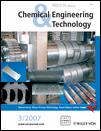Applicability of a Miniaturized Micro-Separator/Classifier to Oil-Water Separation
Abstract
The micro-separator/classifier is miniaturized to approximately 1/2 size of the original device to examine its applicability to oil-water separation. A small amount of oil with density of 930 kg/m3 is dispersed in water. The emulsion is fed into the curved microchannels and is discharged from the inner and outer branches that form the bifurcations. The lighter oil phase is collected from the outer branch. A possibility of simultaneous separation of heavier and lighter phases is brought about by the principle of lift-force induced separation. The cut-size and pressure loss are much smaller than those of existing hydrocyclones. Further, the miniaturized device attains smaller cut-size compared with the larger original device applied to solid separation with larger density difference. The suitability of the device to numbering-up methodology is argued based on the fact that the cut-size is insensitive to total flow-rate.




